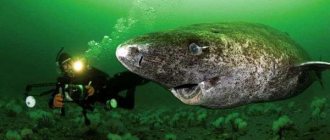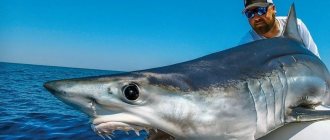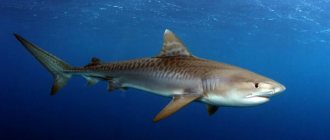The family of sand sharks (Carchariidae or Odontaspididae) includes several closely related species, usually grouped into two genera.
The most typical and well-known representative of the group is also the most widespread. The common sand shark inhabits the coastal waters of continents in the subtropical and partly tropical zones of almost the entire globe (excluding the Pacific coast of America).
Carcharias taurus has many other names. It is called the gray nurse shark, mottled raggedtooth shark, or sand tiger shark. This predator also has an “alternative” Latin name – Odontaspis taurus.
In order not to completely get confused in all these terms, you need to understand that this species has nothing to do with either tiger sharks from the gray or carcharine family, or the nurse sharks themselves.
Distribution of the sand shark.
The sand shark lives in the waters of the Pacific, Atlantic and Indian oceans. It is found in warm seas and avoids the eastern Pacific Ocean. Distributed from the Gulf of Maine in Argentina in the western Atlantic Ocean, to the coasts of Europe and North Africa in the Eastern Atlantic, as well as in the Mediterranean Sea, in addition from Australia to Japan and off the coast of South Africa.
Common sand shark (Carcharias taurus)
Sand shark habitats.
Sandwich sharks are typically found in shallow waters such as bays, surf zones, and areas near coral or rocky reefs. They have been spotted at a depth of 191 meters, but most likely prefer to stay in the surf zone at depths of up to 60 meters. Sand sharks usually swim in the lower part of the water column.
Did you know?
- Tiger sharks can live up to 50 years. Individuals kept in aquariums usually do not live more than a few months.
- This species was first described by the French naturalist Lesueur and zoologist Peron in 1822, but named after the naturalist Cuvier.
- A female tiger shark caught in 1957 had a record size. Its length was 7.4 meters and its weight was 3110 kg. These data, however, have never been confirmed.
- Although these sharks swim very slowly, making them even harder to spot in the water, they can speed up in an instant. Their prey does not have time to escape.
- Tiger sharks have huge home ranges, reaching 23 square kilometers.
External signs of a sand shark.
The dorsal side of the sand shark is gray, the belly is off-white. It is a heavily built fish with distinctive spots on the sides of the body with metallic brownish or reddish spots. Young sharks range in length from 115 to 150 cm. As they mature, sand sharks can grow up to 5.5 meters, but the average size of individuals is 3.6 meters. Females are usually larger than males. Sand sharks weigh 95 - 110 kg.
Recently, a large number of attacks by this type of shark on people have been recorded.
The anal fin and both dorsal fins are the same size. The tail is heterocercal, with a long upper lobe and a short lower one. The different lengths of the caudal fin lobes ensure the fast movement of the fish in the water. The snout is pointed. The oral cavity is equipped with long and thin teeth, sharp as a razor. These elongated teeth are visible even when the mouth is closed, giving sandbar sharks a menacing appearance. Therefore, there was an opinion that these are dangerous sharks, although the fish do not deserve such a reputation.
Reproduction of the sand shark.
Sand sharks breed in October and November. In a population there are usually more males than females in a ratio of 2:1, so several males mate with one female.
Sand sharks are an ovoviviparous species, with females bearing their young for six to nine months.
Spawning occurs in early spring near coastal reefs. The caves where these sharks live are also used as spawning grounds and, if they collapse, the breeding of sand sharks is interrupted. Young females give birth once every two years, producing a maximum of two young. The female has hundreds of eggs, but when the eggs are fertilized, the fry develop jaws with teeth at 5.5 cm in length. Therefore, some of them eat their brothers and sisters while still inside the mother; in this case, intrauterine cannibalism takes place.
There is little information about the lifespan of sandbar sharks in the ocean, however those kept in captivity live on average between thirteen and sixteen years. They are believed to live in the wild even longer. Sand sharks breed at the age of 5 years and grow throughout their lives.
Breeding season
Photo: Melissa Cristina Marquez
The tiger shark has a very unusual reproductive strategy. It is the only ovoviviparous member of its family. The female tiger shark gives birth to live young, just like its close relatives, the hammerhead sharks, but unlike them, tiger sharks do not use the placenta to nourish the developing embryos. Instead, tiger shark embryos develop from relatively large eggs during the initial stages of development. When the yolk supply is depleted, the developing embryo switches to drinking uterine fluid as a source of nutrition through a process called "embryotrophy" in later stages of development. This method of reproduction, in which animals are born alive but do not feed through the placenta, is called ovoviviparity.
Females look for a mate every three years . The mating system is polygamous. The gestation period ranges from 13 to 16 months. The female can give birth to from 10 to 80 cubs with a length of 51-104 cm and a weight of 3-6 kilograms. In the Northern Hemisphere, mating occurs from March to May, and young are born from April to June of the following year. In the Southern Hemisphere, the young are thought to hatch between November and January.
Sand shark behavior.
Sand sharks travel in groups of twenty individuals or less. Group communication promotes survival, successful reproduction and hunting. Sharks are most active at night. During the day they stay close to caves, rocks and cliffs. This is not an aggressive species of shark, but caves occupied by these fish should not be invaded; they do not like to be disturbed. Sand sharks swallow air and store it in their stomachs to maintain neutral buoyancy. Because their dense fish bodies sink to the bottom, retaining air in their stomachs, so they can remain motionless in the water column.
Sand shark populations from the Northern and Southern Hemispheres may make seasonal migrations to warm waters, towards the poles in summer and towards the equator in winter.
Sand sharks are sensitive to electrical and chemical signals.
They have pores on the ventral surface of the body. These pores serve as a tool for detecting electric fields, which help fish detect and find prey and navigate the Earth's magnetic field during migration.
Taxonomy and phylogeny[edit]
The small-toothed sand tiger was originally described as Squalus ferox
by the Italian-French naturalist Antoine Risso in 1810, based on a specimen from Nice, France.
[2] In 1950, Gilbert Percy Wheatley described O. grassti
from Australian specimens, separating it from
O. ferox
on the basis of dentition and lack of spots.
Leonard Compagno named the two species synonymously in 1984 because subsequently discovered Pacific specimens blurred Wheatley's distinctive features. [3] The specific epithet ferocious
is Latin for "cruel".[4] Other common names for this shark include blue nurse shark, ferocious shark, Herbst nurse shark, and sand tiger shark. [5]
A phylogenetic study based on mitochondrial DNA by Naylor et al.
in 1997, suggests that the smalltooth sandtiger and its relative, the bigeye sandtiger (
O. noronhai
), are more closely related to thresher sharks than to the gray nurse shark, with which it is closely similar. If true, it would mean that the similarities between this species and the gray nurse shark resulted from convergent evolution. [6] Fossil teeth of the fine-toothed sand tiger were found in the Lower Pliocene from 5.3 to 3.6 million years ago (Ma) in sediments in Italy and Venezuela. [7] [8]
Sand shark feeding.
Sand sharks have a varied diet; they feed on bony fish, stingrays, lobsters, crabs, squids, and other types of small sharks. They sometimes hunt together, chasing fish in small groups and then attacking them. Sandwich sharks attack their prey with frenzy, like most sharks. In large numbers, marine predators feel safe and attack a school of fish in close proximity.
Ecosystem role of the sand shark.
In ocean ecosystems, sandbar sharks are predators and regulate the populations of other species. Different species of lampreys (Petromyzontidae) parasitize sharks, attaching to the body and receiving nutrients through the blood through the wound. Sand sharks have a mutualistic relationship with pilot fish, which clean their gills of contaminants and eat organic debris lodged in the gills.
Eating habits
The tiger shark is an omnivore, and its diet is almost unlimited. Preferred prey varies by geographic region, but typically includes sea turtles, jellyfish, stingrays, molluscs, bony fish, sea snakes, squid, seabirds, dolphins, various crustaceans, and carrion. These sea creatures even feed on members of the shark kingdom, including other tiger sharks, indicating that they are prone to cannibalism . Occasionally, land dwellers such as horses, sheep, rats, goats, dogs and cats also appear on their menu.
The tiger shark's serrated teeth, combined with the saw-like motion of shaking its head back and forth, allow it to rip chunks off of much larger sea animals such as whales. In Hawaii, 25 tiger sharks were observed attacking a humpback whale.
Interestingly, human-made items can often be found in the stomach of this animal. They sometimes eat inedible items such as empty oil drums, license plates and balls. That's why tiger sharks are sometimes called "the trash of the oceans .
One large female caught off the northern tip of the Gulf of Aqaba in the Red Sea contained two empty cans, a plastic bottle, two burlap bags, a squid and a 20cm fish in her belly. Garbage and waste are often found in the stomachs of sharks caught in harbors and estuaries, where they are usually dumped into the water. Although human remains are far from a natural food item, they sometimes end up in the guts of these carrion sharks.
Tiger sharks are solitary hunters who feed mainly at night, when the animal swims further from the shore and stays closer to the surface. They can sometimes be seen in groups, but this is probably due to food availability rather than social behavior.
Links[edit]
- ^ ab Pollard, D.; Gordon, I.; Williams, S.; Flaherty, A.; Fergusson, I.K. (2003). » Odontaspis ferox » . IUCN Red List of Threatened Species
.
2003
. Retrieved April 25, 2009. CS1 maint: ref=harv (link) URL of old form - Risso, A. (1810). Ichthyologie de Nice, ou, Histoire naturelle des poissons du département des Alpes Maritimes. Paris: F. Schöll. pp. 38–39. DOI: 10.5962/bhl.title.7052.
- ^ B s d e g h i JK Fergusson, IK; Graham, K. J., & Compagno, L. J. V. (2008). "Distribution, abundance and biology of the smalltooth sandbar shark Odontaspis ferox
(Risso, 1810) (Lamniformes: Odontaspididae)".
Ecological biology of fish
.
81
(2):207–228. DOI: 10.1007/s10641-007-9193-x. S2CID 1874623. - Jump up
↑ Ebert, D. A. (2003).
Sharks, Rays and Chimaeras of California
. London: University of California Press. pp. 93–95. ISBN 978-0-520-23484-0. - ^ abc Froese, Rainer and Pauly, Daniel, eds. (2009). "Odontaspis ferox" in FishBase. Version from April 2009
- Naylor, G. J. P.; Martin, A.P.; Mattison, E. G., & Brown, W. M. (1997). "Relationships of lamniform sharks: testing phylogenetic hypotheses with sequence data". In Kocher, T. D. & Stepien, C. A. (Eds.). Molecular systematics of fish. San Diego: Academic Press. pp. 199 -218. ISBN 978-0-12-417540-2.
- Cappetta, H. (1987). "Chondrichthyes II. Mesozoic and Cenozoic elastobranchia". Handbook of Paleoichthyology (Volume 3B)
. Stuttgart: Gustav Fischer Verleg. pp. 85–110. - Jump up
↑ Aguilera, O. & Aguilera, D. R. (2001).
"An exceptional assemblage of coastal upwelling fishes in the Caribbean Neogene". Journal of Paleontology
.
75
(3):732–742. DOI: 10.1666/0022-3360 (2001) 075 <0732: AECUFA> 2.0.CO; 2. HDL: 10088/1377. JSTOR 1307055. - ^ B s d e g h i Compagno, L. J. V. (2002). Sharks of the World: An Annotated and Illustrated Catalog of Shark Species Known Today (Volume 2)
. Rome: Food and Agriculture Organization. pp. 64–66. ISBN 978-92-5-104543-5. - ^ ab Roberts, Clive; Stewart, A.L.; Struthers, Carl D.; Barker, Jeremy; Korte, Salme; Freeborn, Michelle (2015). Fishes of New Zealand
.
2
. Wellington, New Zealand: Te Papa Press. paragraph 59. ISBN 9780994104168. OCLC 908128805. - Martin, R. Aidan. "Biology of the lumpy-toothed shark (Odontaspis ferox)". elasmo-research.org
. ReefQuest Shark Research Center. Retrieved January 31, 2019. - Duffy, Clinton AJ; Francis, Malcolm; Dunn, M.R.; Finucci, Brit; Ford, Richard; Hitchmuff, Rod; Rolfe, Jeremy (2018). Conservation status of New Zealand chondrichthyans (chimaeras, sharks and rays), 2016 (PDF). Wellington, New Zealand: Department of Conservation. paragraph 10. ISBN 9781988514628. OCLC 1042901090.











